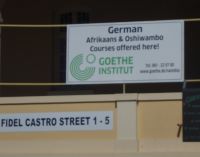To answer the question of what’s at the corner of Luderitz Strasse and Fidel Castro Street, it’s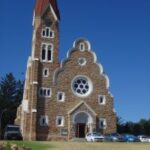 the Goethe Institute which houses the Goethe Café (on one corner) and the headquarters of the Lutheran Church here. Both the Castro reference and the Teutonic emphases help explain contemporary Namibia.
the Goethe Institute which houses the Goethe Café (on one corner) and the headquarters of the Lutheran Church here. Both the Castro reference and the Teutonic emphases help explain contemporary Namibia.
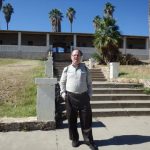
The German influence, as I’ve suggested earlier, is pronounced, although its history as German Southwest Africa ended in 1915 or 1916. Part of the heritage is in the architecture. Cultural relics abound, including the old Christ kirche, a Lutheran Church that looks gingerbread-like outside and has a Rubens copy painting inside (probably a fake imported from China, like so many other things), the Hochschule (not sure I got the spelling 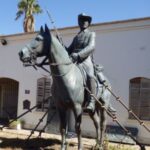 right) which houses part of the museum of Namibia, and my favorite, the Alte Feste, the old fort/headquarters of the German army in SWA, with its crenelated castle towers and a huge statue erected in honor of the “Fallen Soldaten” in world war I nearly half a century later. The discussion we had at the Embassy pointed out that many German habits still prevail (people stop at the stop lights), and many of the restaurants feature German fare (I had schnitzel the other day).
right) which houses part of the museum of Namibia, and my favorite, the Alte Feste, the old fort/headquarters of the German army in SWA, with its crenelated castle towers and a huge statue erected in honor of the “Fallen Soldaten” in world war I nearly half a century later. The discussion we had at the Embassy pointed out that many German habits still prevail (people stop at the stop lights), and many of the restaurants feature German fare (I had schnitzel the other day).
The Fidel Castro reference is equally important in explaining recent Namibian history (which also has a spillover effect on business, especially on US businesses). Simply, the good guys who helped Namibia liberate itself from South Africa, as the Namibians perceive it, were Cuba, Russia, China, and North Korea. For example, I went to the new museum of history, built by North Korea (I’d never before heard of North Korean construction companies going anywhere beyond their borders!). Inside, what I saw would have made Kim (anyone of the three) immensely proud, because the vocabulary and displays were “socialist realism.” There were exploited 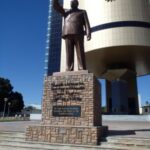 workers both in historical pictures and in artwork right out of the Chinese mold (the founder of the Republic stands statuesque in front, looking for all the world like Mao/Kim with a slightly different face–he does have a beard). The pictures (and that was most of the exhibit) didn’t give any context, but I could imagine the struggle for liberation from the displays. The country finally became independent in 1990 (March 21 if you want to win the trivial pursuit game), with the assistance of the United Nations.
workers both in historical pictures and in artwork right out of the Chinese mold (the founder of the Republic stands statuesque in front, looking for all the world like Mao/Kim with a slightly different face–he does have a beard). The pictures (and that was most of the exhibit) didn’t give any context, but I could imagine the struggle for liberation from the displays. The country finally became independent in 1990 (March 21 if you want to win the trivial pursuit game), with the assistance of the United Nations.
That allegiance of SWAPO, the party of the revolution, and the party which has run the country since, is tilted toward the communist bloc. Many of the businesses are state-owned, and we learned that the sentiment is that “profit is bad,” which has had a salutary effect on the corporate social responsibility of businesses that want to operate in this country. One of our speakers, from 3M, sells respiratory devices to mining companies, and its entry strategy has been to give free training to mine owners who were convinced that towels and cloth masks were sufficient to prevent silicosis (!) And, until recently, the parliament members were on the committee to scrutinize applications from companies desiring to do business here, or invest here (most of the mines are foreign owned, the capital requirements being too great for locals to manage, though about 95% of the workers are local—at least 80% have to be—and, the Chamber of Mines economist assured us, at least 70% of the revenue remains in Namibia. I thought it was fitting that her title was “economist,” but her training was in journalism.) The mines are a major contributor to the GDP. As I understand it, there is a new $6 b Chinese-owned uranium mine soon to open that will add 5% to the GDP of the country. And the economist also assured us, miners’ pay is relatively high, both within Namibia and in the African mining industry.
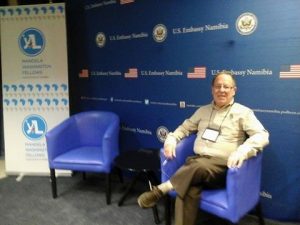
The bias has some interesting effects. A government tender for a railroad led to 8 bids, which went to a Chinese company. The seven losers contested, and the proposal was rebid with 7 bidders. The result was the Chinese won again. The port of Walvis Bay is being expanded with Chinese construction (some of the subcontracting is going to Caterpillar). I’m beginning to get the picture now; the battle is partly for the interior-the Botswana and Zambia and Zimbabwe. The port will require additional infrastructure, especially railroads, and we saw some plans (there are a lot of plans in and for Africa) for linking Walvis Bay with other countries. The embassy told us even now it’s more efficient to ship to Walvis Bay than to the South African ports.
All this may be changing. There is an American-educated President (the first) who is less skeptical about the motives of the United States (and Obama’s presidency has helped here, too), though the commercial attache related a story about telling the Minister of Foreign Trade how important the “ease of doing business in” and other ratings are in attracting foreign investment only to be told, “But countries lower than us get the most money.” We’re having a reception at the embassy tomorrow, so maybe we’ll get more of a sense of what is happening in this large (think Alaska), thinly populated (2 million) and environmentally varied and naturally attractive country.
Gotta go essen!
